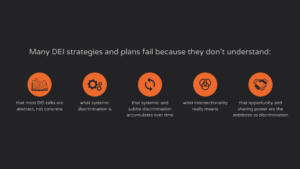This is a free, practical, online set of resources for improving Diversity, Equity, and Inclusion (DEI) for organisations that want to make DEI efforts more effective and efficient.
Why DEI strategies fail

Many DEI strategies and plans fail because they don’t understand:
- that most DEI frameworks should talk in concrete terms, not in abstract terms,
- what is systemic discrimination and why it is like poison,
- that systemic and subtle discrimination accumulates over time,
- what Intersectionality really means and how it adds more nuances that need to be addressed, and
- that providing opportunities, creating safe spaces, and sharing power are the antidotes to discrimination.
This means having the courage to take on board uncomfortable truths. All we can do is to tell you what is really needed for change, to “burst your bubble”, so that you can decide for yourself if you have the courage to take action.
“Thank you for spending the time and mental effort to articulate these uncomfortable truths so clearly in front of an audience that needs to hear it.” – Anonymous.
These resources are for people who need an introduction into Diversity and Inclusion as well as those who might feel that they aren’t getting the results their efforts deserve. They have already made a positive impact.
The goal is to understand what we really need to do to effect change.
There are multiple ways to get started – we have ways to help you if you are practically minded, theoretically minded or visual!
Key Resources for Diversity and Inclusion
Practical ways to get started
For those wanting to get a feel at a practical level, you could look at any one of the following:
- 18 ways you can help as an individual right now
- 10 key tips to make the recruitment process more inclusive
- Extending Diversity, Equity, and Inclusion best-practice in recruitment for international not-for-profits
- Recent position descriptions that have been improved for Diversity, Equity and Inclusion
- Helping intersectionally marginalised people as an individual
- Using Intersectionality to underpin a conference
- Empowering Refugee Communities: A Practical Guide to Diversity, Equity, and Inclusion
- Are you really hiring on merit? A story about hiring senior management with Diversity and Inclusion
Theoretical ways to get started
For those wanting to understand the key theoretical concepts, you can look at these in order:
- Systemic imbalance still exists
- Subtle discrimination can be worse than overt discrimination
- Neutral sides with oppression
- Redefining merit to handle “All snakes and no ladders”
- Intersectionality increases the degree of difficulty
- Opportunity is the antidote to discrimination
Visual ways to get started
For those wanting to understand the key theoretical concepts through visualisations, you can look at these in order:
- Systemic imbalance still exists
- Neutral sides with oppression
- Redefining merit to handle “All snakes and no ladders”
- Intersectionality increases the degree of difficulty
- The “Problem” Woman of Colour in NonProfit Organizations
- What a “minor” event looks like to a marginalised person vs a privileged person
- Lack of concrete, practical discussions around DEI
- Opportunity is the antidote to discrimination
- Intersectionality Spectrum Framework
The three key frameworks
Here are the three underlying frameworks that we use to embed DEI into organisations and that individuals can use everyday:
- Capability Maturity Model for Diversity in Organisations
- Intersectionality Spectrum Framework
- 12 DEI Discourse Analysis Framework
Longer Introductions
For longer introductions to the frameworks you can read:
- 15 minute introduction to Diversity & Inclusion for workplaces
- The 1 hour presentation Improving Diversity and Inclusion in Senior Leadership.
Reasons why this resource exists
- To leverage these resources to allow privileged individuals to take up “the fight” at their own
organisations without having to expose themselves to a high amount of risk. - To allow those who want to change (contemplation stage of the Transtheoretical model of
behaviour change) to work through the discomfort in a safe space to get to the other side as a
proactive ally. - To dismantle the idea that we hire on merit. If we cannot change this narrative, all the other work
will be subject to legal and informal attack. - Longer term, to change the system so that diversity becomes a key skill looked for at senior management levels.
Sign up for newsletter